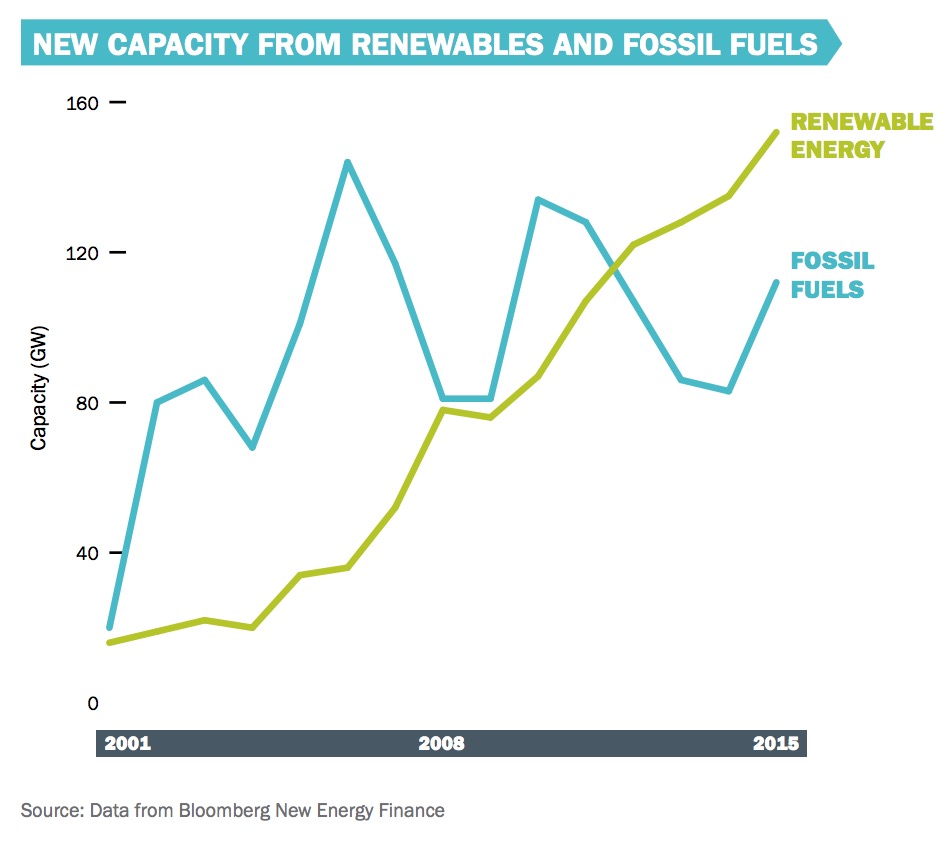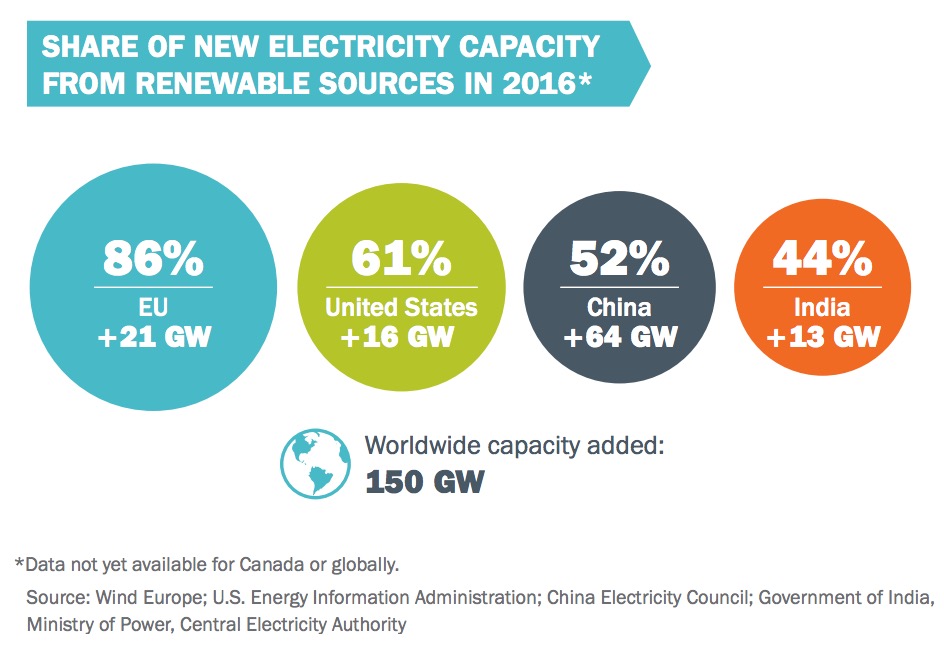CLEAN ENERGY CANADA
Executive Summary
The Point of Great Returns
Tipping points: those elusive moments when a technology goes mainstream.
Much has been written in the debate over whether renewable energy has passed, is fast-approaching, or is still a ways from crossing that threshold.
The true tipping point will only become apparent in the rearview mirror, and it won’t be defined by a single moment or breakthrough. It will be crossed at different times, in different countries, driven by different forces. But the clean energy transition now appears irreversible.
In developed and developing countries alike, fossil fuels are falling out of favour as a source of electricity. They are being beat out by renewable power that is clean, increasingly cost-competitive and a fast-growing source of economic opportunity.
The world’s three largest electricity markets—China, the United States and India—have aggressively pursued renewable power and were collectively responsible for half of global clean energy investment in 2016.
In both China and India, renewable energy offers a critical solution to the pollution choking fast-growing cities. Smog has become increasingly disruptive— socially, economically and politically—closing schools in Delhi, grounding airplanes in China and contributing to the premature deaths of millions of citizens.
In the U.S., the renewable energy sector has become a major job creator: since 2009, the solar industry created one out of every 80 new jobs, and the country’s fastest-growing occupation is wind turbine technician. While President Donald Trump may have promised to bring back coal jobs, he will no doubt find resistance—in both Congress and statehouses—should his efforts come at the expense of clean energy jobs.
While total clean energy investment fell in 2016 from the record-breaking total in 2015, new renewable electricity capacity rivalled the previous year. Sustained policy efforts by governments, coupled with the continued drop in clean energy technology costs, have created the conditions for more clean electrons to be squeezed out of every dollar spent.
Global growth in renewable energy remains policy-driven, but increasingly that policy is harnessing the competitive forces of the market. This approach has further driven down costs and inspired technology innovation, new business models and market design. Competitive auctions for contracts to build new renewable energy projects are leading to record-low prices that increasingly undercut their fossil fuel competitors.
But the evolution of our electricity system is not without its challenges. They range from decentralizing supply, to integrating variable sources of power like wind and solar, to building new transmission lines connecting power-rich regions with those in need of clean electrons. China serves as a good example: in some regions, wind farms and solar fields are being built faster than they can be integrated, leaving them stranded from the grid or forced to reduce output.
Investment in renewable power waned in Canada in 2016, as our electricity system is already dominated by power from fossil-free sources and electricity demand is relatively stable. But we know from experience how to harness and maximize the value of renewable electricity. We have a clean energy technology sector that punches above its weight and companies hungry to sell their solutions beyond our borders. Helping other countries increase their use of renewable power may be where Canada finds its niche—and economic opportunity—in the global clean energy transition.
As the U.S. government retreats from international climate diplomacy, clean energy innovation and free trade, it leaves a gap that Canada is well-positioned to fill. And it’s clear that if we don’t step up, somebody else will.
Renewable Power Holds Its Edge
 Since 2012, the world has brought more power online from renewables than fossil fuels each year—and that trend continued in 2016. Solar had a record-breaking year, with 73 gigawatts (GW) of new capacity coming online—nearly half of the total renewable power added globally. Meanwhile, wind power had its second-best year ever, delivering over 56 GW of new capacity. Overall, the amount of new renewable power capacity installed in 2016 came in just shy of the record set in 2015, with 150 GW installed.
Since 2012, the world has brought more power online from renewables than fossil fuels each year—and that trend continued in 2016. Solar had a record-breaking year, with 73 gigawatts (GW) of new capacity coming online—nearly half of the total renewable power added globally. Meanwhile, wind power had its second-best year ever, delivering over 56 GW of new capacity. Overall, the amount of new renewable power capacity installed in 2016 came in just shy of the record set in 2015, with 150 GW installed.
Solar Outshines Its Competition in World’s Largest Electricity Systems
In 2015, the amount of solar power installed in China set a world record. China smashed that record again in 2016, adding 30 GW of new capacity—or roughly enough solar panels to cover three soccer fields every hour.
 China wasn’t alone in the record-breaking department in 2016. In the U.S., solar installations—including both rooftop and utility-scale—nearly doubled over 2015, adding 14 GW. Utility-scale solar additions of 8 GW represented 39% of new utility-scale capacity in the U.S., taking the crown as the top new source of power in the country.
China wasn’t alone in the record-breaking department in 2016. In the U.S., solar installations—including both rooftop and utility-scale—nearly doubled over 2015, adding 14 GW. Utility-scale solar additions of 8 GW represented 39% of new utility-scale capacity in the U.S., taking the crown as the top new source of power in the country.
In India, remarkably low-cost renewable auction bids drove new solar capacity, which more than doubled relative to 2015 to become the second-largest source of new power in the country. India also built the world’s largest solar plant, covering 10 square kilometres and providing 648 MW of clean electricity capacity.
Leading Nations Ease Off Investment
While new renewable power capacity stayed about even relative to 2015, total clean energy investment deals fell 26% to C$348 billion. That still represents over a third of a trillion dollars, contributing to a global investment of C$2 trillion in clean energy over the past five years.
Yet investment fell by nearly one third in China and more than half in Japan as the clean energy building boom eased off. Both countries are now focused on “digesting” the vast amounts of new renewable energy capacity added in recent years.
China, in particular, has struggled to align the pace at which it’s adding new renewable energy capacity with how quickly it’s building transmission lines and integrating new power sources. Over the first three quarters of 2016, 19% of China’s wind power production was “curtailed”— effectively wasted. The Chinese government now aims to reduce the curtailment rate to 5% within five years.
In the U.S., investment dropped by 9% after a surge of development in late 2015, when it was uncertain whether Congress would extend federal wind and solar tax credits beyond that year. (Good news: it did.)
Download full version (PDF): The Transition Takes Hold
About Clean Energy Canada
cleanenergycanada.org
“We raise understanding and awareness of market trends, innovations, policies, and success studies, both in Canada and around the world. We regularly brief policy makers, journalists, business leaders, and others. We also produce, commission, and distribute original research and analysis, including economic modelling and public-opinion research.”
Tags: Clean Energy Canada, PVs, Renewables, Solar, Solar Energy, Wind, Wind Energy







 RSS Feed
RSS Feed